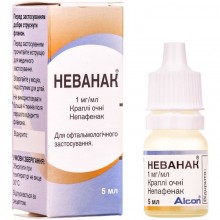



 Secure and encrypted payment processing
Secure and encrypted payment processing We ship to over 40 countries including the USA, UK, Europe, Australia and Japan
We ship to over 40 countries including the USA, UK, Europe, Australia and Japan Guaranteed refund or reship if you haven't received your order
Guaranteed refund or reship if you haven't received your orderEye drops "Nevanac®"Used by adults for:
The active substance is nepafenac (1 ml of suspension contains 1 mg of nepafenac).
Excipients: benzalkonium chloride, carbomer 974P, tyloxapol, disodium edetate dihydrate, mannitol (E 421), sodium chloride, sodium hydroxide and / or concentrated hydrochloric acid (for pH adjustment), purified water.
Hypersensitivity to the active substance, any of the components of the drug or other non-steroidal anti-inflammatory drugs (NSAIDs).
"Nevanac®"Contraindicated in patients in whom the use of acetylsalicylic acid or other NSAIDs causes asthma attacks, urticaria or acute rhinitis.
For ophthalmic use.
Inform the patient about the need to thoroughly shake the bottle before use.
If several drugs are used at the same time for topical application in the eyes, the interval between their use should be at least 5 minutes.
To prevent contamination of the dropper tip and solution, do not touch the eyelids and other surfaces with the dropper tip. Keep the bottle tightly closed when not in use.
Do not exceed recommended doses.
To prevent and treat pain and inflammation, instill one drop of Nevanac®"3 times a day into the conjunctival sac of the affected eye (s), starting 1 day before the operation to remove the cataract, then on the day of the operation and in the postoperative period of up to 21 days as prescribed by the doctor. An additional drop of the drug should be used 30-120 minutes before surgery.
To reduce the risk of macular edema after cataract surgery in patients with diabetes mellitus, one drop of Nevanac should be instilled®"3 times a day into the conjunctival sac of the affected eye (s), starting 1 day before cataract surgery, then on the day of surgery and in the postoperative period of up to 60 days according to the doctor’s prescription. An additional drop of the drug should be used 30-120 minutes before surgery.
Data on the effect of the drug "Nevanac®"On the human body are absent. This medicine should not be used by women of reproductive age who do not use appropriate methods of contraception.
There is no adequate data on the use of the drug for pregnant women. During animal studies, reproductive toxicity was detected. The potential risk to human reproductive function is unknown. Since the systemic effect of the drug "Nevanac®"On the body of non-pregnant women slightly, the risk of using this drug during pregnancy can be considered low. However, since a delay in the synthesis of prostaglandins can adversely affect pregnancy and / or development of the embryo / fetus, and / or childbirth, and / or postnatal development, it is not recommended to use the drug Nevanac®"During pregnancy and women of reproductive age who do not use contraceptives.
It is not known whether nepafenac passes into breast milk. Animal studies have shown that nepafenac passes into the breast milk of rats. However, the negative effect of the drug on the baby is not expected, since the systemic effect of nepafenac on the body of a woman who is breastfeeding is very insignificant. Thus, the drug "Nevanac®"Can be used while breastfeeding.
Safety and efficacy of the drug "Nevanac®"Children are not established, therefore this medicine is not recommended for use by children.
As with other eye drops, temporary blurred vision or other visual impairment can affect the ability to drive vehicles or other mechanisms. If blurred vision occurs during instillation, the patient must wait until vision is restored before driving or working with other mechanisms.
There is no evidence of an overdose of the drug when instilled into the eyes. There is very little chance that the use of more than one drop in the eye will lead to adverse reactions. The occurrence of adverse reactions with accidental ingestion of the drug is not expected.
During clinical trials, the most common adverse events were keratitis, eye pain, and the formation of scales along the edges of the eyelids, which were observed in 0.5% of patients.
Store at a temperature not exceeding 30 ° C, out of the reach of children.
Shelf life - 2 years (after the first opening of the bottle - 4 weeks).